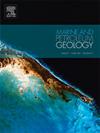埃及地中海北三角洲盆地上新世-更新世生物事件、层序生物地层学与古环境
IF 3.6
2区 地球科学
Q1 GEOSCIENCES, MULTIDISCIPLINARY
引用次数: 0
摘要
包括有孔虫、纳米浮游生物和苔藓虫在内的综合高分辨率生物地层学方法以及测井资料是圈定近海三角洲盆地上新世—更新世演替的年龄评价和油气储集层的主要贡献。孢粉学资料为层序元素的定位和沉积环境的解释提供了进一步的依据。用有孔虫指纹鉴定了三个鞭毛囊组合,并对其进行了年代地层校准。确定了6个有孔虫生物事件:圆孔虫Acme Sphaeroidinellopsis和nepenthes globoturborotalia margaritae Globorotalia puncticulata、圆孔虫Sphaeroidinellopsis、圆孔虫Globigerinoides extremus和balthica Hyalinea first occurrence (FO)。利用新的约束年代地层构型和高分辨率生物地层数据,可以更准确地描述和对比整个盆地的不整合面和体系域。识别出7个地层构型旋回,有助于更好地描述储层非均质性。相的分布和发育受全球起伏变化的控制,并伴有局部构造作用。底栖生物相、有孔虫多样性、鞭毛藻组合和纳米浮游生物古生态标志表明,盆地在上新世早期被斜坡河道中断。纳米浮游生物和有孔虫标记物丰度的变化表明,上新世晚期至更新世期间海平面下降。本文章由计算机程序翻译,如有差异,请以英文原文为准。
Pliocene–Pleistocene bioevents, sequence biostratigraphy and paleoenvironment of the Mediterranean North Delta Basin, Egypt
Integrated high-resolution biostratigraphic approach including foraminifera, nannoplankton and palynomorphs as well as logging data are the main contribution to delineate the age assessment and hydrocarbon reservoirs of the Pliocene–Pleistocene succession of the offshore Delta Basin. The palynological data adds considerable further justifications for positioning sequence elements and interpreting the depositional environment. Three dinoflagellate cyst assembelages are identified and chronstratigraphically calibrated with the foraminiferal fingerprints. Six foraminiferal bioevents are recognized: Acme Sphaeroidinellopsis and last occurrences (LOs) of Globoturborotalita nepenthes, Globorotalia margaritae, Globorotalia puncticulata, Sphaeroidinellopsis, Globigerinoides extremus and first occurrence (FO) of Hyalinea balthica. With the use of the new constrained chronostratigraphic architecture and high-resolution biostratigraphic data, unconformities and system tracts throughout the basin may be more accurately described and correlated. Seven cycles in the stratigraphic architecture were identified, which helps to better describe the reservoir heterogeneity. Facies distribution and development were controlled by global eustatic change, being accompanied by local tectonics. Benthic biofacies, foraminiferal diversity, dinoflagellate assemblage and nannoplankton paleoecological markers indicate a deepening of the basin, interrupted by slope channels during the early Pliocene. The turnover in the abundance of nannoplankton and foraminiferal markers shows sea-level drop during the late Pliocene and Pleistocene epoch.
求助全文
通过发布文献求助,成功后即可免费获取论文全文。
去求助
来源期刊

Marine and Petroleum Geology
地学-地球科学综合
CiteScore
8.80
自引率
14.30%
发文量
475
审稿时长
63 days
期刊介绍:
Marine and Petroleum Geology is the pre-eminent international forum for the exchange of multidisciplinary concepts, interpretations and techniques for all concerned with marine and petroleum geology in industry, government and academia. Rapid bimonthly publication allows early communications of papers or short communications to the geoscience community.
Marine and Petroleum Geology is essential reading for geologists, geophysicists and explorationists in industry, government and academia working in the following areas: marine geology; basin analysis and evaluation; organic geochemistry; reserve/resource estimation; seismic stratigraphy; thermal models of basic evolution; sedimentary geology; continental margins; geophysical interpretation; structural geology/tectonics; formation evaluation techniques; well logging.
 求助内容:
求助内容: 应助结果提醒方式:
应助结果提醒方式:


